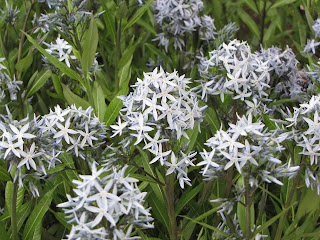Amsonia tabernaemontana is quite a garden trooper. My
respect for this plant, commonly called Blue Star Flower, has gained ground
this year given its outstanding, and unexpected, performance during this year's drought. Dr. Allan Armitage has been
extoling the virtues of this garden plant for years (Thanks Allan!) but did I
listen? Not until about five years ago. And I must admit – I’m a little
slow but I did, finally, get it.
Amsonia tabernaemontana is a lovely U.S. native plant
with a range that stretches from the lower east coast to the Great Plains, growing in sites from moist shade to dry, full sun locations steeped in limestone. Although right now this is touted as adaptability within this specific species, I think we'll see some separations and/or species re-classifications in the future.
Early in
the spring, Blue Star Flower pokes through the soil surface, the tips resembling large,
purplish-green asparagus spears. The 2’ – 3’ stems sport 2” wide, dark green
leaves are lovely as they open and develop in spring. But even though I love shades of green - oh - the leaves
cannot compare to the icy glow of the pretty, star-shaped blue flowers that sit atop
the stems in May.
 |
| Amsonia tabernaemontana flowers will fade to a pale, icy blue as they age. |
Conditions for good growth and root development are not
difficult to provide – these plants are quite adaptable. Again - I have to say, the drought tolerance was quite surprising. If placed in rich soil, the
plant will grow very well, quickly developing stem height. And while for many plants
that would be a desirable result, for Amsonia tabernaemontana, it will result in a floppy
structure - especially given that the plant is tall with a natural tendency to a vase-like
shape, plentiful leaves and flowers make the stem weighty at the top. The
plants will love you if just placed into a decent site.
 |
| Nice shape! |
Full sun is suggested
for the best growth but I’ve seen some fantastic plantings in shade as well. If
the plants do flop over, whether it’s from too much shade, fast growth, or rich
soil, feel free to give them a trim after flowering. Although I, personally,
have not felt the need – you can cut them back to within a foot of the ground
after flowering to get nice dense, leafy growth. Or if you’re one of those
gardeners that just want your plants to present a neat and tidy appearance, and
have no need for the seed heads, trimming them back just little may make your
life complete. Go for it.
Want more? Division is an easy way to multiply your
population of Amsonia tabernaemontana. You won’t need to divide very often (every 8 – 10 years)
but when you do, early spring or fall are great times to get your shovel in the
ground and split a healthy crown apart. Be sure to include at least one growth
point in each division. Propagation via seed is purported to be easy and
successful although it does take a few years to develop plentiful flowering. Terminal
cuttings (use rooting hormone), taken early in the season, are also an effective
method of propagation.
Amsonia tabernaemontana problems are difficult to locate. Makes them a treat to grow. I can see the potential for root rot in consistently wet soils but that problem is
our fault for poor site choice, not a plant health liability. Try as I might to locate any critter/insect feeding or damage on the plantings – I have not. Again – a treat.


